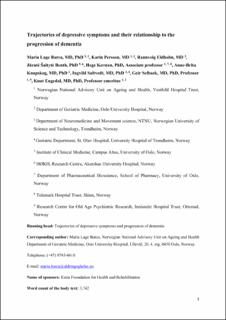| dc.contributor.author | Barca, Maria Lage | |
| dc.contributor.author | Persson, Karin | |
| dc.contributor.author | Eldholm, Rannveig Sakshaug | |
| dc.contributor.author | Saltyte Benth, Jurate | |
| dc.contributor.author | Kersten, Hege | |
| dc.contributor.author | Knapskog, Anne-Brita | |
| dc.contributor.author | Saltvedt, Ingvild | |
| dc.contributor.author | Selbæk, Geir | |
| dc.contributor.author | Engedal, Knut | |
| dc.date.accessioned | 2020-06-25T07:43:07Z | |
| dc.date.available | 2020-06-25T07:43:07Z | |
| dc.date.created | 2017-07-18T10:30:38Z | |
| dc.date.issued | 2017 | |
| dc.identifier.citation | Journal of Affective Disorders. 2017, 222 146-152. | en_US |
| dc.identifier.issn | 0165-0327 | |
| dc.identifier.uri | https://hdl.handle.net/11250/2659407 | |
| dc.description.abstract | Background The relationship between progression of Alzheimer's disease and depression and its underlying mechanisms has scarcely been studied. Methods A sample of 282 outpatients with Alzheimer's disease (AD; 105 with amnestic AD and 177 with Alzheimer's dementia) from Norway were followed up for an average of two years. Assessment included Cornell Scale for Depression in Dementia and Clinical Dementia Rating Scale (CDR) at baseline and follow-up to examine the relationship between AD and depression. Additionally, MRI of the brain, CSF dementia biomarkers and APOE status were assessed at baseline. Progression of dementia was defined as the difference between CDR sum of boxes at follow-up and baseline (CDR-SB change). Trajectories of depressive symptoms on the Cornell Scale were identified using growth mixture modeling. Differences between the trajectories in regard to patients’ characteristics were investigated. Results Three distinct trajectories of depressive symptoms were identified: 231 (82.8%) of the patients had stable low-average scores on the Cornell Scale (Class 1); 11 (3.9%) had high and decreasing scores (Class 2); and 37 (13.3%) had moderate and increasing scores (Class 3). All classes had average probabilities over 80%, and confidence intervals were non-overlapping. The only significant characteristic associated with membership in class 3 was CDR-SB change. Limitations Not all patients screened for participation were included in the study, but the included and non-included patients did not differ significantly. Some patients with amnestic MCI might have been misdiagnosed. Conclusion A more rapid progression of dementia was found in a group of patients with increasing depressive symptoms. | en_US |
| dc.language.iso | eng | en_US |
| dc.relation.uri | http://www.sciencedirect.com/science/article/pii/S016503271730397X?via%3Dihub | |
| dc.rights | Attribution-NonCommercial-NoDerivatives 4.0 Internasjonal | * |
| dc.rights.uri | http://creativecommons.org/licenses/by-nc-nd/4.0/deed.no | * |
| dc.subject | Dementia | en_US |
| dc.subject | Depression | en_US |
| dc.subject | Memory clinic | en_US |
| dc.subject | Mild cognitive impairment | en_US |
| dc.subject | Prognosis | en_US |
| dc.subject | Trajectory | en_US |
| dc.title | Trajectories of depressive symptoms and their relationship to the progression of dementia | en_US |
| dc.type | Peer reviewed | en_US |
| dc.type | Journal article | en_US |
| dc.description.version | acceptedVersion | en_US |
| dc.rights.holder | Copyright © 2017 Elsevier. | en_US |
| dc.source.pagenumber | 146-152 | en_US |
| dc.source.volume | 222 | en_US |
| dc.source.journal | Journal of Affective Disorders | en_US |
| dc.identifier.doi | 10.1016/j.jad.2017.07.008 | |
| dc.identifier.cristin | 1482481 | |
| cristin.unitcode | 1991,9,1,0 | |
| cristin.unitname | Avd Alderspsykiatri | |
| cristin.ispublished | true | |
| cristin.fulltext | postprint | |
| cristin.qualitycode | 1 | |

